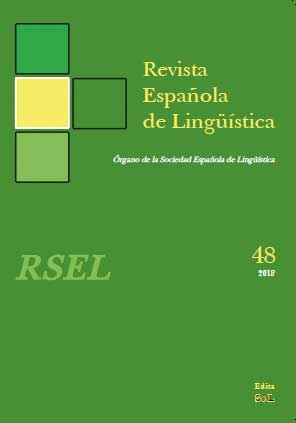El efecto de referencia disjunta en pasivas con ser y estar
doi: http://doi.org/0.31810/RSEL.48.6
Palabras clave:
ser; estar; pasivas; estructura argumental; lectura reflexiva.Resumen
Este artículo estudia el efecto de referencia disjunta en construcciones pasivas con ser y estar, que consiste en la imposibilidad de tener una lectura reflexiva. Muestro, basándome en un estudio empírico realizado a hablantes de castellano peninsular, que dicho efecto se produce en la pasiva con ser pero no en la pasiva con estar, y desarrollo una propuesta teórica para dar cuenta de los datos. Mi estudio contribuye a una comprensión más completa de las propiedades de los participios pasivos con ser y estar en español, y constituye una aportación al estudio actual de las pasivas verbales y adjetivales en diferentes lenguas.
Descargas
Citas
Alarcos Llorach, E. (1970): Estudios de gramática funcional del español, Madrid, Gredos.
Alexiadou, A., Gehrke, B. y Schäfer, F. (2014): «The argument structure of adjectival participles revisited», Lingua 149, pp. 118-138.
Anagnostopoulou, E. (2003): «Participles and voice», en Alexiadou, A., Rathert, M., y von Stechow, A. (eds.), Perfect explorations, Berlín, Mouton de Gruyter, pp. 1-36.
Arad, M. (1998): VP Structure and the Syntax-Lexicon interface, Tesis doctoral, UCL. Baker, M., Johnson, K., y Roberts, I. (1989): «Passive arguments raised», Linguistic Inquiry 20, 2, pp. 219-51.
Bosque, I. (1990): «Sobre el aspecto en los adjetivos y en los participios», en Bosque, I. (ed.), Tiempo y aspecto en español, Madrid, Cátedra, pp. 177-214.
Bruening, B. 2014. «Word formation is syntactic: adjectival passives in English», Natural Language and Linguistic Theory 32, pp. 363-422.
—, (2013): «By-Phrases in passives and nominals», Syntax 16, pp. 1-41.
Bull, W. (1965): Spanish for teachers, Nueva York, Ronald Press.
Carrasco, F. (1973): «Sobre el formante de la voz pasiva en español», RSEL 3, 2, pp. 333-341.
Conti Jiménez, C. (2004): «Construcciones pasivas con estar», ELUA 18, pp. 21-44.
Criado del Val, M. (1975): Gramática Española y comentario de textos, Madrid, Saeta.
Doron, Edit (2013): «The interaction of adjectival passive and voice», en Borer, H., Alexiadou, A. y Schäfer, F. (eds.), The roots of syntax and the syntax of roots, Oxford, Oxford University Press, pp. 164-191.
Fábregas, A. y Marín, R. (2017): «On non-dynamic eventive verbs in Spanish», Linguistics 55, 3, pp. 451-488.
Fernández-Ramírez, S. (1951): Gramática española. El verbo y la oración, Vol. 4, Madrid, Arco Libros.
García Pardo, A. (2017): «Aspect and argument structure in adjectival passives», Borealis: An International Journal of Hispanic Linguistics 6, 1, pp. 21-52.
Gómez Torrego, L. (1988): Perífrasis verbales, Madrid, Arco Libros.
Hallman, P. (2013): «Predication and movement in passive», Lingua 125, pp. 76-94.
Harley, H. (2013): «External arguments and the Mirror Principle: On the distinctness of Voice and v», Lingua 125, pp. 34-57.
Hengeveld, K. (1986): «Copular verbs in a functional grammar of Spanish», Linguistics 24, pp. 393-420.
Hernández Alonso, C. (1982): Lengua Española II, Madrid, UNED.
Kratzer, A. (1996): «Severing the external argument from the verb», en Rooryck, J. y Zaring, L. (eds.), Phrase structure and the Lexicon, Dordrecht, Kluwer, pp. 109-137.
—, (2000): «Building statives», en Conathan, L., Good, J., Kavitskaya, D., Wulf, Alyssa, B., y Yu, A. (eds.), Proceedings of the 26 Meeting of the Berkeley Linguistics Society, Berkeley, Berkeley Linguistics Society, pp. 385-399.
—, (2002): The event argument, Ms., University of Massachusetts.
Marcos Marín, F. (1980): Curso de gramática española, Madrid, Cincel.
Marín, R. (2000): El componente aspectual de la predicación, Tesis doctoral, UAB.
McIntyre A. (2013): «Adjectival passives and adjectival participles in English», en Alexiadou, A y Schäfer, F. (eds.), Non-Canonical passives, Ámsterdam, John Benjamins, pp. 21-42.
Mendikoetxea, A. (1999): «Construcciones inacusativas y pasivas», en Bosque, I. y Demonte, V. (eds.), Gramática descriptiva de la lengua española, vol. 2, Madrid, Real Academia Española/Espasa Calpe, pp. 1575-1630.
Navas-Ruiz, R. (1987): Usos de ser y estar, Madrid, Sociedad Española de Librería.
—, (1977): Ser y estar: El sistema atributivo del español, Salamanca, Almar.
Pylkkänen, L. (2000): «On stativity and causation», en Tenny, C., y Pustejovsky, J. (eds.), Events as grammatical objects: The converging perspectives of lexical semantics and syntax, CSLI Publications, pp. 417-445.
Ramchand, Gillian C. (2008): Verb meaning and the lexicon: A first phase syntax, Cambridge, Cambridge University Press.
Spathas, G., Alexiadou, A, y Schäfer, F. (2015): «Middle voice and reflexive interpretations: Afto-Prefixation in Greek», Natural Language and Linguistic Theory 33, 4, pp. 1293-1350.
Publicado
Cómo citar
Número
Sección
Derechos de autor 2018 Revista Española de Lingüística

Esta obra está bajo una licencia internacional Creative Commons Atribución-NoComercial 4.0.











